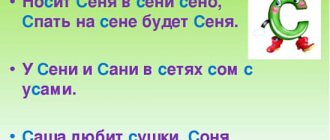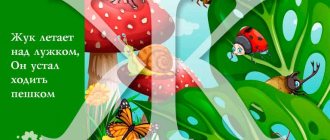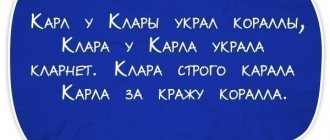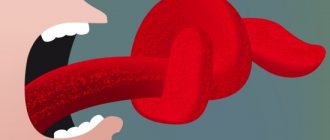Let's finish the noodles, hurry up and make everyone laugh again
Tongue twisters starting with the letter Ш for 1st grade
***
The mouse crawled under the lid, To gnaw the crumb under the lid, The mouse must be dead - The mouse forgot about the cat!
***
You can hear a rustling in the reeds, It makes your ears ring, A hundred young frogs frighten the Heron with their whispers.
***
Our Masha was given semolina porridge. Masha is tired of the porridge, Masha hasn’t finished the porridge, Masha, finish the porridge, Don’t bother Mom!
***
The leaves rustle. Whispers whisper with the grass. The silence faded into silence. “Hush, hush...” I heard.
***
Tiny cats ate cakes. Tiny cats love cakes. The cats crushed the cakes with their paws. The cats from the cakes filled our tummies.
***
Tishka Stealthily drags Kishmish out of the bag. Quiet! Kishmish is not a mouse, So, little rascal, Shoo... S. Belorusets
***
The schoolboy was getting ready for school, opening the closet, he got dressed: He put on a fur coat, a hat, a scarf - He walked to school and began to sweat.
***
When I'm in a hurry, I eat noodles. I'll finish the noodles and hurry. I'm in a hurry. Noodle noodles. Well, I'll make everyone laugh again.
***
The sunflowers look at the sun, and the sun looks at the sunflowers. But the sun has many sunflowers, And the sunflower has only one sun. Under the sun, the sunflower laughed sunnyly while it matured. Ripe, dried up, pecked.
***
In the silence of the forest, Whisper hurries towards Rustle. Whispers rush to Rustle. Whispers rustle through the forest. - Where are you going? - I'm flying to you. Let me whisper in your ear: Shu-shu-shu and shi-shi-shi, Hush, rustle, don’t rustle, Prick up your ears - Listen to the silence!.. Do you hear? - I hear. -What do you hear? - There are mice scurrying around somewhere.
***
You even stained your neck, even your ears with black mascara. Get in the shower quickly. Rinse the mascara off your ears in the shower. Rinse off the mascara from your neck in the shower. After your shower, dry yourself off. Dry your neck, dry your ears, and don’t dirty your ears anymore.
***
Our Dasha fed semolina porridge to the cat Masha. And Dasha fed Vavila the goose. And the puppy Antoshka got a spoonful of porridge. There wasn't enough porridge Only for Dasha herself. We need to cook the porridge again. Come out - you should drive...
In this video there are several other tongue twisters starting with the letter Sh: easy and more complex. Your kids will hear how to pronounce tongue twisters correctly and clearly.
How are hissing sounds produced?
You already know that consonant sounds are formed when air passes through various barriers in the oral cavity: lips, teeth, tongue. When overcoming obstacles, noise is produced. Some consonants have a voice added to the noise. Therefore, we distinguish between voiceless consonants (formed only from noise) and voiced consonants (obtained by combining voice and noise). Examples: voiceless consonants are t, f, s, voiced consonants are d, v, z.
Hissing sounds also belong to consonants. They are placed in a separate group due to their educational characteristics.
Let's take a walk through the Magic Forest and get to know the hissing sounds in detail. Many animals and birds live in the huge Magic Forest. Take a look around.
Here in the clearing a hedgehog is trying to catch a dragonfly, and the hedgehogs are playing hide and seek near a tree stump. Nearby, a hare is looking after her little bunnies, and they are cheerfully whispering about something.
In a forest lake, a predatory fish, the pike, has gone hunting, and the spiny fish, the ruffe, is learning to swim long distances.
But an important titmouse bird sat down on a cherry tree branch. She carefully watches the guests of the forest.
Guys, say the words out loud:
- hedgehog, hedgehog, important;
- hare, hares, prickly, bird, titmouse;
- predatory, pike;
- ruff, cherry.
What consonant sound is there in each word in the line numbered 1? (sound [zh]). On the line number 2? (sound [h]). Under the number 3? ([sch]). Under the number 4? ([w]). These sounds: Zh, Ch, Shch, Sh are called hissing consonant sounds.
If you listen closely, you can hear these sounds in our forest. A bumblebee flew by. How does it buzz?
A snake slithered through the grass. She saw the danger and hissed.
The sparrows are noisily discussing something.
The squirrel cracks nuts.
There are many of these sounds in the world around us. Why are they called hissing? Let's listen to what the Wise Owl will explain to us about this.
Hissing sounds are divided into voiced and unvoiced.
The sound [zh] is pronounced with the participation of noise and voice: zh-zh-zh. It is ringing: heat, buzzing, yellow.
And the sounds [ch'], [sh], [sh'] are formed with the participation of only noise, so they are dull: a cup, a hut, a sliver.
The hissing zh–sh form a pair in terms of sonority and deafness: heat-shar, pity-shawl, gesture-six. The sounds h, sch do not have a pair in terms of voiceness.
In terms of softness and hardness, not a single sibilant forms a pair with other consonants. The hissing sounds [zh], [sh] are always hard consonants: beetle [beetle], rustle [shorah].
The sounds of soft consonants in all situations are produced by hissing [ch'], [sch']: hours [ch'asy], brush [sh'otka].
Spelling sibilants in combination with vowels and consonants
Guys, to be literate, you need to know the rules for writing letters in different words. Today we will learn the spelling of sibilants with vowels, find out how the combinations chk, chn, cht, schn are written.
Rules for writing cha-sha, chu-shu, zhi-shi
Hissing sounds are not friendly with all vowels. Listen to the story from the Wise Owl about why this happened.
“How the hissing ones stopped being friends with Y, Yu, Ya”
Once upon a time, the hissing Zh, Sh, Ch, Shch, together with the vowels A, I, Y, U, Yu, Ya, decided to go into the forest to pick mushrooms. The sun was shining brightly, the trees rustled their leaves welcomingly. Mushrooms sat under almost every leaf and blade of grass. And then the berries themselves ask to be added to the basket.
The hissing ones didn’t notice that they went in a completely different direction and got lost. They look around: the places are unfamiliar, and there are no vowels nearby. They tried to scream and call for help. It's all to no avail. Zh's voice is weak, while Sh, Ch, Shch have only noise and hissing. It's already getting colder, it will start getting dark in an hour. What to do?
And suddenly they see: there are notches on the tree trunks. Someone cut out the letters: A, I, U, as if showing the way. And the hissing ones walked along the path along which there were notches in the trees. Soon they heard the sounds of “Ay! Ay!”, a drawn-out song “E-i-i-i!” and ran towards the screams. Finally, they came out to a familiar clearing. And there the vowels are already waiting for them: I, A, U. How the sounds rejoiced at each other!
But then the hissers noticed that Yu, Y, Ya were missing among the vowels. It turns out they refused to look for the hissers, because they thought that they themselves were to blame for everything. They wanted to rest, and they went home.
The hissing consonant sounds were so upset that since then they have not been friends with Yu, Y, Ya, who abandoned them in trouble, but only go with A, I, U.
What is this fairy tale about, guys? That friends should not be left in trouble, you need to help them or call adults.
Here's a rule you need to remember:
Let's practice correctly identifying a vowel after a sibilant, and complete the task of the Wise Owl.
Exercise “Find the word”
Match the pictures with the corresponding words and fill in the missing letters in the words.
Answer: cone, shield, teapot, lampshade, toad, hat, key.
Spelling of hissing ch in combinations: chk, chn, cht, nch, schn, nsch
Guys, read the words in the columns.
horse benefit donut
laziness mill twig
stump blizzard mail
steering wheel fight racer
mole skates predator
How is the softness of consonant sounds in words in the first column indicated? Answer: using the sound [e] and ь. How is the softness of the consonants indicated in the second column? Answer: vowel sounds [e], [i], b.
Look at how the softness of the consonants is indicated in the third column. Answer: only with vowel sounds [e]. Tell me, does the vowel [i] in the words donut, racer affect the softening of the sounds [ch'], [sch']? Why? Answer: because they are unpaired soft consonants.
Now pay attention to how softly the combinations nch, chk, cht, nsch, schn are pronounced in the words of the third column. Is there a soft sign between these combinations? No. Why do you think? Is it needed? Answer: no, it’s not necessary, because the sounds ch, sch are always soft.
Soft sibilants influence and soften other consonant sounds that come after them. In the word drummer we hear soft n [n'], although there is neither a softening vowel nor b nearby. The same thing happens in the words: chick, suitcase, ice cream man.
Let's write down the transcriptions of these words:
- drummer – [drum'sh'ik]
- chick – [pt'en'ch'ik]
- suitcase – [ch'imadan'ch'ik]
- ice cream maker – [marozhyn'sch'ik]
Softness in the combinations nch, chk, cht, nsch, schn is indicated in transcription for two sounds [n] and [ch'].
Breathing exercises
Poor and shallow breathing, disturbances of which occur during a conversation, lead to various speech defects, including a lisp. To eliminate the cause, it is necessary to perform exercises to develop speech breathing:
- “The hissing of geese” - a person places his feet shoulder-width apart and rests his hands on his hips. Gradually he leans forward, stretching his neck and pronouncing the sound “sh” during a long exhalation. The exercise is performed slowly - from 3 to 10 seconds. The number of repetitions is 5-6.
- Improved speech articulation is observed when performing “mower” gymnastics. The starting position of the legs is similar to the previous exercise. In this case, your arms should be bent at the elbows and moved forward. Fingers clenched into a fist. When turning the body left and right, a person imitates movements with a scythe, waving his arms widely and saying “zhuk-zhuk!” The movements should not be made quickly, their speed should be comfortable. The required number of repetitions is 5-7 times.
- A second person is required for the “sawing wood” exercise. You should stand opposite him face to face. Feet should be shoulder-width apart, however, the left leg is slightly forward. Both participants take each other’s hands and alternately bend and unbend them, imitating the movements when sawing firewood. During the exercise, you must pronounce the sound “zh”. The pace should be moderate. The task lasts 30-60 seconds.
- The “locomotive” exercise can be performed at any age. A person walks in small steps around the room or in place. The arms are bent and move back and forth. While moving, the person says “chug-chug,” imitating the sound of a train. The duration of the task is up to 1 minute.
Options for games with tongue twisters:
- Tongue twisters with the sound “Ш” in the form of mnemonic tracks, disassemble into words and find words with the sound “Ш”;
- Find words where in the tongue twister the sound “Ш” is at the beginning of the word, in the middle of the word;
- Come up with your own funny sentence using this word;
- Connect the two parts of the tongue twister and pronounce it;
- Say a tongue twister cheerfully, sadly, with fear, quietly, loudly;
- Guess with what intonation your partner pronounced the tongue twister;
- Say a patter and the intonation of a famous cartoon or fairy tale character (for example, the Wolf from Seven Little Goats or Matroskin the Cat from Prostokvashino, etc.);
Tongue twisters for the development of speech and diction in children using whistling sounds S, Z, C
There are several options for violating the pronunciation of these sounds:
- The tip of the tongue is inserted between the teeth. The result is an unclean “s” and “z” (whispering).
- When the front part of the tongue is in a normal position, the middle part of its back is not lowered enough. The results are softened sya and zy (syanki, zyamok).
- “S” and “z” are replaced by other sounds, often “sh”, “zh”, less often in the younger group “f” to “v” (shapog, zhamok, fapok, vamog). Among toddlers this goes away over time.
- C is replaced by the sounds “s”, “t”, “ch” (saplya, taplya, chaplya).
Tongue twisters for the development of speech and diction in children using whistling sounds S, Z, C
Tongue twisters for the development of speech and diction in children using whistling sounds S, Z, C
Tongue twisters for the development of speech and diction in children, younger schoolchildren 8, 9, 10, 11, 12 years old
Children over eight years old have fully formed speech. Children pronounce all sounds well. At the same time, they can construct long and false sentences. The vocabulary is huge. Among the most common problems is poor diction. The child does not speak clearly, mumbles or swallows some words because he is in a hurry. Experiences, stress and nervous shock negatively affect a child’s diction. You need to fight bad diction; there are a lot of exercises and tongue twisters for this.
Diction problems:
- Speech therapists believe that about 30% of the entire world population suffer from diction disorders. This is most often due to the characteristics of speech development and living environment. If one of the parents burrs, stutters, or pronounces hissing words incorrectly, then the child can adopt this feature.
- Most often the problems are with hissing ones. The sounds themselves are pronounced, but articulation is impaired. As a result, there is a violation of diction.
- A large part of poor diction is the mispronunciation of “r”. Most often this is due to incorrect pronunciation and weak muscles. Diction can be improved by training your muscles and pronunciation.
Below are tongue twisters to improve schoolchildren's diction and train their muscles.
Tongue twisters for the development of speech and diction in children, younger schoolchildren 8, 9, 10, 11, 12 years old
Tongue twisters for the development of speech and diction in children, younger schoolchildren 8, 9, 10, 11, 12 years old
Mnemonic tracks of tongue twisters:
Tongue twisters for the sound “Ш” in the form of mnemonic tracks - fascinating chains of pictures, interconnected in meaning. As you know, preschool age is the age of visual thinking, and children perceive many images through pictures. Therefore, mnemonics are exactly what will help children learn all speech material more easily and easily.
Speech material:
- Snakes don’t live where hedgehogs live.
- The hedgehog has a hedgehog, the snake has a squeeze.
- The hedgehog is lying by the Christmas tree, the hedgehog has needles.
- One day it rained twice.
- I even need dinner already.
- The bear cubs are not harmed by hedgehogs or snakes.
- In Luzhniki, skiers ran along the track on skis.
- The terrible heat makes Zhenya dizzy.
- It's terrible for a beetle to live on a bitch.
- The snake was stung by a wasp, the hedgehog feels terribly sorry for him.
- The hedgehog is waiting for the snake for dinner, the hedgehog needs it for dinner.
- The little snake and he had dinner in a puddle.
- You can't run through a puddle on skis.
- It’s a pity that we won’t put boots on Zhuchka’s feet.
- The janitor held the door for two days, the wooden house shook. The wind tugged at the door in the house, the janitor thought it was an animal.
- The hedgehog, the hedgehog, and the hedgehog, and the swift, the swift, and the little bear were frightened.
- Hedgehogs and grass snakes lived in the living corner.
- Hedgehogs became friends with mice in the rye.
- They went into the reeds - and there were no souls in the rye.
- The ground beetle buzzes, buzzes and spins.
- The toad sat in the puddle, looking greedily at the beetle. The beetle buzzed, buzzed, buzzed and came to her for dinner.
- Centipedes have too many legs.
- The beetle buzzes over the lampshade, the ground beetle buzzes, buzzes and spins.
- A good pie - there is curd inside.
- Live and don't worry.
- Snakes don’t live where hedgehogs live.
- Already in a puddle.
- I need a hedgehog for dinner.
- The crane is not a suitor for the toad.
- Once upon a time there was a beetle, there was a beetle on life.
- A fly buzzed, a spider buzzed...
- The hedgehog washed his ears, neck, and skin on his belly in the bathhouse.
- And when a wolf meets him, a click comes at the hedgehog with its teeth.
- The hedgehog showed his needles, the wolf ran away in fear.
- The snake hisses and the beetle buzzes.
- I already gave the hedgehogs a dozen new pajamas.
- The old pajamas were punctured by hedgehogs.
- Zhora already has a beetle, Rosa has a beetle.
- An iron lock in an uninhabited castle has rusted.
- Swifts and siskins are chirping in the grove.
Tongue twisters for the sound “F” using mnemonic tracks are a way to strengthen children’s imaginative thinking, memory and, of course, the development of diction.









